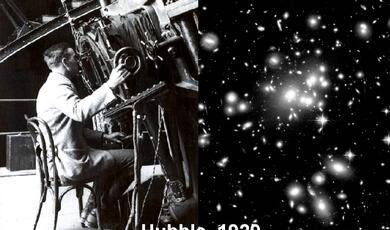Why do we live in three dimensions - or do we?
Share
- Details
- Text
- Audio
- Downloads
- Extra Reading
We are aware of 3D space and the fourth dimension of time. But why is it like this? Why would one or two not have been enough? Why not more? Experiments at CERN will seriously be looking for evidence of a fifth dimension. Science fiction or science fact?
Download Text
Why do we live in three dimensions - or do we?
Professor Frank Close OBE
In Philip Pullman's "The Subtle Knife", Lyra and Will find a "hole in the air"(at the north end of the Banbury Rd in Oxford) through which they can enter into a parallel universe. Though we have never ourselves found this mysterious gateway to "beyond", Oxford scientists, along with thousands form around the world, are planning experiments at the new Large Hadron Collider at CERN, which have on their agenda the search for a fifth dimension. Among the evidence they hope to find is the apparent disappearance of matter and energy from the universe as we know it into dimensions that are currently beyond our ken. Could Philip Pullman's fantasy turn out to be something like reality?
What would a fourth dimension be like? Or even a fifth? Can we be sure that the three that appear to our normal senses - Up-down; forwards and backwards; left and right: are all that there are?. What if there were further dimensions - "within", "beyond"; what effects might they have; how could we be aware of them; can we be sure that there is not more to the universe than we have so far experienced.
Such questions have been favourites of science fiction - the "fourth dimension" was the rage some years ago, but are now becoming asked by serious scientists. Superstring theory appears to provide a unified description of particles and forces, if the universe in the immediate aftermath of the Big Bang had ten dimensions. If so, what happened to them? how can this become proven science fact?
In a lecture like today's I am not going to answer such profound things in any satisfactory way, but we can discuss more down to Earth ones, metaphorically at least. Indeed, why do we need three? Would a universe "work" in two or even one? Are there advantages to being in three?
It is frequently claimed that we could not live in two dimensions because of the problem of the gut in Hawking's camel. I call it Hawking's camel as it appears in a book and lectures, yet as we shall see is quite spurious.
PICTURE OF A CAMEL FROM NUTSHELL UNIVERSE
We eat through our mouth, digest in the stomach and defecate at the other end. The whole is connected by a tube. In a two dimensional world with two dimensional camels the upper and lower half of the beast are disconnected. So the legs walk off leaving the upper body behind. however, a two dimensional world is quite feasible as an excellent book The Planiverse describes. The gut is like a zipper, the two halves unzipping as food passes, reconnecting as it goes through so, the animal staying connected throughout. A two dimensional world is feasible and consistent: physics and biology appear to be possible.
When thinking about what a universe with higher dimensions would be like, it is useful to imagine the world of flatlanders, aware of the two dimensional surface of a membrane, and then examine what could happen if really their flat world is embedded in a three dimensional ``bulk".
Imagine someone moving in the third dimension passing through the 2D membrane. The flatlanders would see the appearance, from ``nowhere", of an entity which would then disappear again. With our 3D vision we can imagine the membrane as a sphere; the creatures could then walk all over it, the advice "go west" in a straight line (around the equator) would come back on itself from the east. This would appear as a mystery: imagine saying goodbye to an intrepid explorer who, years later reappears from the other direction. So might it be for our universe if its 3D are curved in the fourth dimension of time - but we are getting ahead of ourselves.
One feature of three dimensions is that it has enabled us to develop science courtesy of Newton's inverse square law of gravity. Apples fall to earth, as it is bulky and near by. The Sun is very massive but its effects die away as R^{-2}; hence the apple feels the Earth. In turn the Earth feels the pull of the Sun, but remote galaxies, far more massive, have no measurable effect on us. Had the gravitational force been independent of distance, the apple would not fall to Earth, nor even to the Sun: the remote galaxies would determine our gravity. Being the way it is, Newton was able to study apples, Moon and planets as separate independent systems. We can calculate eclipses and tides by the motion of moon and Earth without need for Jupiter, whatever astrologers might believe.
Why is it like this? It is due to the 3D nature of space. The gravitational force-field fills all of space. Imagine a sphere at distance R from the massive source of the force whose gravitational tentacles in effect spread out from the source. The surface area grows as R^2 and so the density of lines crossing the sphere will decrease as R^{-2} . So this behaviour of gravity is intimately connected with the dimensionality of space. Were it 2D, the force would die like 1/R; were it 4D it would die as R^{-3} .
In 4D, this rapid enfeebling of the force leads to unstable planetary orbits; so solar systems (as least as we imagine them) would not survive.
Electric fields also fill space (until captured by landing on some opposite electric charge to that which gave rise to them). The intensity of electromagnetic radiation also dies off as the inverse square.
So we have now the puzzle of why is the sky dark at night. The nearby Sun dominates by day but at night the light from individual stars dies with R^{-2} but their number increases in compensation like R^2 .
So the two should compensate, leaving the night sky as bright as by day. The argument is wrong because it takes no account of the expansion of the universe. As stars depart from us, their light is Doppler shifted to the red, the more so the faster they retreat; and they retreat faster the further away they are.
Thus the light from the remotest galaxies is shifted out of the optical into the infra red and radio wavelengths.
The universe is expanding - in what? Think of the flatlanders again. Their membrane can expand by growing in our third dimension. Our real universe expands in a fourth dimension, time. It is curved in time and expands in time. The idea that time acts like a dimension originates in special relativity; that the universe in curved in ``space-time" due to gravitational forces is the essence of his general theory.
This also merits a series of lectures and is not for today. I will come back to relativity at the end; let's now look at one and two dimensions.
In one dimension the force has nowhere to go and so is constant with distance. The force between quarks is like that at large distances. We met the idea of the colour charge in the last talk, and that the relativistic quantum theory of this force is known as QCD - quantum chromodynamics.
All 3d are there but the flux of the colour-force doesn't fill them; it takes the shortest route between the quarks. Mathematical models of the forces even pretend that the quarks live in an effective one dimensional universe. They even imagine more extreme things: that space and time are not continuous but consist of a discrete set of points - a lattice. Studies of the QCD theory of the quark forces are thus known as Lattice QCD. The equations of QCD are used to infer the probability (technically amplitude) at each point of space and then left to adjust by computing the mutual interaction of one point to another. this is done by computer. Then the separation of points in the lattice is sent to zero so that the continuos space and time of reality are abstracted from the lattice calculations. The ability of the computer to make this extrapolation reliably is what limits the accuracy of this new approach to computation.
In the last talk we hinted how the electromagnetic, weak and strong forces can become unified at energies of some 10^{15}GeV . But gravity is feeble and does not fit into this idea. Or at least it didnt until recently when higher dimensions entered the lexicon of theorists. The story starts with Kaluza and Klein over half a century ago. After Einstein wrote his theory of gravity - general relativity, based on the 4D universe of space and time - Kaluza and Klein wrote down these same equations but in 5D. Then they imagined that one of these dimensions is restricted to a very small size - in analogy is ``curled" up. The picture is like a drinking straw: what appears to be a simple line is seen at high resolution to have an internal structure. When Kaluza-Klein imposed this on their 5D gravity theory they recovered Einstein's 4D gravity of course, but the equation that emerged from the lost 5th dimension turned outto be the familiar Maxwell's equations of electromagnetism. So in this picture, the electromagnetic force is gravity in a fifth dimension.
Now roll the story forward 50 years. To the electromagnetic force now add the weak and the strong - unknown to Einstein. The discovery that relativity is consistent for particles as extended string like structures, admittedly on astonishingly small scales, some 10^{-35}m , led to the modern string theories with 10 dimensions, six of which shrivelled and four grown out of the Big Bang. Why six and four and not 5 and 5? You may well ask; this is one of the many puzzles to be solved. Out of the maths of string theory has developed a more mature picture involving ``branes".
Think of the 2D picture again.
Imagine us as flatlanders and an electrically charged particle emits radio electromagnetic radiation across the 2D sheet. Gravity according to Einstein curves space and time and its effects will permeate the whole bulk of higher dimensional space-time. To people and things confined to the sheet (known as a "brane") the "remnants" of gravity will appear enfeebled. This could explain the unnatural weakness of gravity relative to the other forces. However, as gravity is now filling all dimensions it will die out faster than R^{-2} , which is bad as experiment shows that the strength of gravity does fall off in accord with the famous inverse square law.
But there is a way out. Back to our 2D world. Suppose that there is another 2D sheet that is some (small) distance away, in the third (i.e. higher dimension) from our sheet. If the neighbouring brane acts as a sink for the gravitational force, we will experience the inverse square law at least for distances greater than the scale of the higher dimension (the separation of the two branes in the higher dimension). In this picture gravity fills the bulk space between the two branes.
The inverse square law is untested for distances smaller than about a millimetre. So it is possible that there is a parallel world brane separated from ours by up to a millimetre in a fifth dimension (ours being in three of space and one time dimension).
Electric and magnetic forces (and the weak and strong too) only operate on the brane. They do not propagate between the two. So we cannot see the neighbouring "shadow brane". This gives one possible way of testing these bizarre ideas.
Suppose that there are galaxies of stars that exist on a shadow brane "adjacent" to ours. Their gravity acts within their braneworld, holding them in motion much as we are used to, and also spill out into the bulk that separate them from us. That gravity reaches us and is felt by us. But we do not see those stars as electromagnetic radiation is confined to the shadow brane. This could be the source of the mysterious "dark matter" that we met in the previous talk.
Another consequence is the appearance and disappearance of things. If in our 2D flatland, a creature from the third dimension passed through, the flatlander would only be aware of it while some of its 3D volume was in contact with the 2D sheet. The flatlander would see something begin to grow out of nothing, peak in size and then die out again. In our real world, where the bulk is in the fifth dimension, it is possible that the ultimate foundations of reality may be revealed at the LHC - Large Hadron Collider at CERN. At the energies of the LHC it is possible that, if these ideas on branes are correct, the effects of gravity could be enhanced such that gravitons are emitted from colliding particles. These can escape into the fifth dimension, taking energy and momentum with them.
So we will be looking for evidence that energy and momentum are not conserved in collisions at the LHC. If this occurs, and in a systematic manner in line with detailed predictions, then we may find proof that there is indeed a fifth dimension. The idea that we are accompanied by a shadow brane (or maybe several!) could move from science fiction to science fact. Scientists are already speculating that branes might collide and that the energy could spawn new branes. Thus it is speculated that the collision between two branes 15 billion years ago spawned the brane that we call our universe.
If such an idea sounds crazy, then muse on the following. When someone commented that a young scientist's idea was "crazy", as a derogatory statement, the great Neils Bohr replied in the following positive way: "maybe; but is it crazy enough?" The real breakthroughs appear crazy at first; wait fifty years and they are part of standard college physics. Watch this (five dimensional?) space!
© Frank Close, 9 April 2002
This event was on Tue, 09 Apr 2002
Support Gresham
Gresham College has offered an outstanding education to the public free of charge for over 400 years. Today, Gresham College plays an important role in fostering a love of learning and a greater understanding of ourselves and the world around us. Your donation will help to widen our reach and to broaden our audience, allowing more people to benefit from a high-quality education from some of the brightest minds.


 Login
Login






